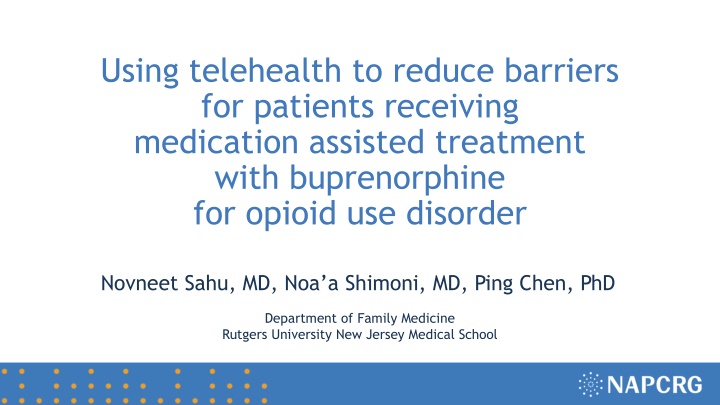
Telehealth Improves Continuity of Care for Buprenorphine Treatment
Explore how telehealth reduces barriers for patients receiving buprenorphine treatment for opioid use disorder, leading to higher rates of continuity of care. Discover findings from the research study conducted at Rutgers University and its implications for clinical practice in underserved populations.
Download Presentation

Please find below an Image/Link to download the presentation.
The content on the website is provided AS IS for your information and personal use only. It may not be sold, licensed, or shared on other websites without obtaining consent from the author. If you encounter any issues during the download, it is possible that the publisher has removed the file from their server.
You are allowed to download the files provided on this website for personal or commercial use, subject to the condition that they are used lawfully. All files are the property of their respective owners.
The content on the website is provided AS IS for your information and personal use only. It may not be sold, licensed, or shared on other websites without obtaining consent from the author.
E N D
Presentation Transcript
Using telehealth to reduce barriers for patients receiving medication assisted treatment with buprenorphine for opioid use disorder Novneet Sahu, MD, Noa a Shimoni, MD, Ping Chen, PhD Department of Family Medicine Rutgers University New Jersey Medical School
The Research Question Is there a difference between the rates of patient continuity for patients receiving buprenorphine treatment via telehealth versus in- person in a primary care outpatient setting?
Research Design and Method Dataset: EPIC electronic medical records from an urban university-affiliated ambulatory primary care practice in New Jersey. Patients receiving buprenorphine treatment for opioid use disorder during a 2-year period May 2019-May 2021. Intervention: Establishment and implementation of HIPAA compliant telehealth following approved state guidelines for buprenorphine prescribing via telehealth. Appointments were scheduled in-person or telehealth by patients preference. Outcome measures: Rates of continuity (>2 visits) by visit type
What the Research Found Population characteristics: 69% Black, 22% Hispanic, and 9% other Majority were enrolled in Medicaid 80% of patients faced one or more barriers to social determinants of health including transportation, housing, and economic stability Results: 487 patients seen via telehealth 61% continued to receive follow up care 811 patients seen in-person 49.3% continued to receive follow up care p<.0001
What this means for Clinical Practice Continuity of care is higher using telehealth for patients receiving medication assisted therapy for opioid use disorder. In an urban underserved population, telehealth can result in improved continuity of care Telehealth may reduce barriers to accessing care including transportation, work schedule, childcare, and other competing demands.






















